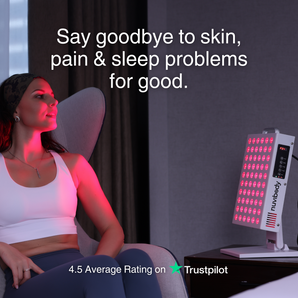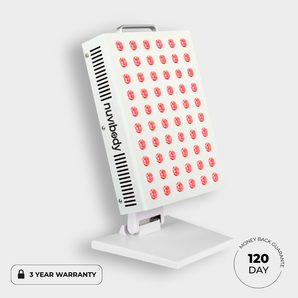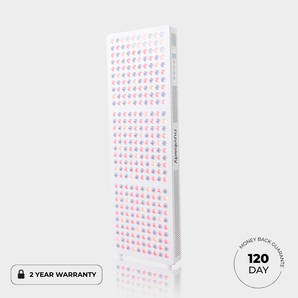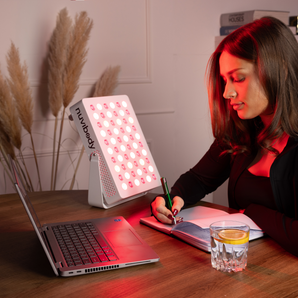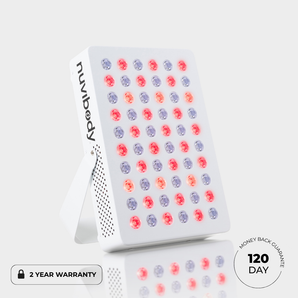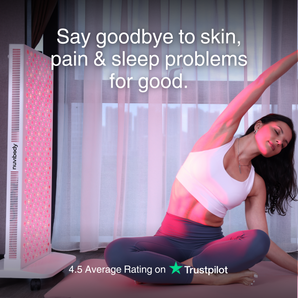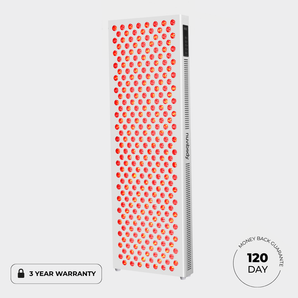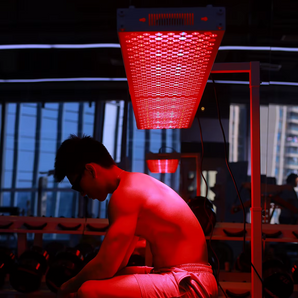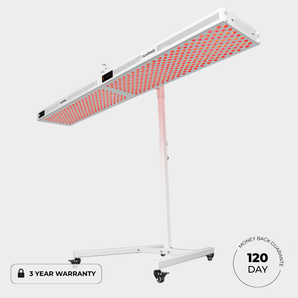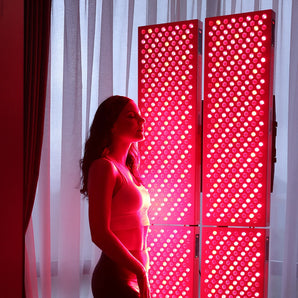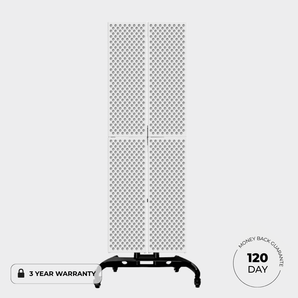Many people use red light therapy for skin, recovery, and energy. But what if you're also working on vitamin D? Can red light therapy benefit your vitamin D status, or are they two completely different topics? In this article, we'll lay out the facts and offer practical tips for cleverly combining the two.
What exactly does red light therapy do?
Red light therapy uses red (approximately 630–660 nm) and near-infrared light (around 810–850 nm) to stimulate mitochondria. This increases cellular energy (ATP), supports repair processes, and can reduce inflammation . In the skin, this often translates into a more supple texture, less redness, and faster recovery after irritation or exertion. For muscles and joints, it can contribute to less stiffness and faster recovery after exertion.
Important to know: red and near-infrared light are not UV light. UV is precisely the group of wavelengths that triggers vitamin D production in the skin. This brings us to the core question.
Does red light therapy produce vitamin D?
Short answer: no. Vitamin D is synthesized in the skin when UVB light (approximately 290–315 nm) converts 7-dehydrocholesterol into previtamin D3. Red light and near-infrared lie at a completely different point in the spectrum and do not cause this conversion. Therefore, you cannot use red light therapy as a replacement for sunlight or doctor-recommended vitamin D supplementation.
That doesn't mean red light therapy has "nothing to do with vitamin D." There are two interesting indirect connections:
- Skin condition and blood circulation
Healthy, less inflamed skin with good microcirculation is generally better able to perform normal functions. Although red light therapy does not produce vitamin D, it can help support skin condition, which can indirectly benefit regular skin processes. - Daily rhythm and sleep
Red light in the evening disrupts the circadian rhythm less than bright blue light. Better sleep can support all sorts of hormonal and immunological processes. This isn't a direct vitamin D boost, but health is a chain of links.
How do you get enough vitamin D?
Vitamin D comes primarily from three sources: sunlight (UVB), diet (oily fish, fortified products), and supplementation. In late autumn, winter, and early spring, the UVB angle in Northern Europe is low, and your skin produces little to no vitamin D, even during the middle of the day. During these months, diet and supplementation are the most practical route. Always consider personal advice from your doctor, especially if you have known deficiencies, dark skin, spend limited time outdoors, or wear clothing that covers your skin.
Some light systems also offer UV settings, but UV exposure poses risks to skin and eyes and requires precise dosing and medical precautions. Red light therapy remains popular because it is non-UV and therefore generally more pleasant and has a wider range of applications.
Smart combination: red light therapy in addition to your vitamin D routine
View red light therapy as a complementary building block alongside sun, nutrition and supplementation:
- Morning: seize daylight for rhythm
Brief exposure to natural daylight after waking helps your biological clock. Combine this with a session of red light therapy later in the day for recovery or skincare. - Afternoon: safe sunbathing, sensible dosage
In summer, short, responsible exposure of the arms and legs can be sufficient for vitamin D, depending on skin type and UV index. Protect your skin from sunburn. Red light therapy doesn't replace these UVB exposures, but it doesn't necessarily interfere with them either. - Evening: recovery and skin
A 10–15-minute session of red light therapy in the evening can be beneficial for relaxation without disrupting your melatonin production. It's useful after exercise or as part of your skincare routine.
Practical dosage for skin and recovery
For general skin goals and recovery, the following guidelines are often used:
- Duration: 8–15 minutes per area
- Frequency: 3–5 times per week, 6–8 weeks; then maintenance
- Distance: usually 15–30 cm, depending on intensity
- Wavelengths: combinations in the red and near-infrared range (approximately 630–850 nm)
Consistency is more important than perfection. Start slowly, evaluate after a few weeks, and build on it as needed.
What should you pay attention to when choosing a lamp?
Since dosage depends on actual intensity per cm², quality of measuring and construction is essential.
- Transparent specifications
Look for devices with honest power ratings and preferably spectrometer measurements alongside "solar meter" references, so you can realistically determine session durations. - Safety and testing
CE certification and 3rd party testing provide confidence that electrical safety, EMC and performance have been verified. - Ease of use
A built-in timer, stable suspension and consistent output make it easier to maintain a routine.
Nuvibody devices are among the most powerful on the market and have undergone third-party testing to ensure safety. Want to try them out at home with peace of mind regarding service and returns? Then Nuvibody is the right choice for you.

What can you realistically expect?
- Not: Vitamin D production. UVB is required for this, not red or near-infrared.
- Yes: Supports skin quality, potentially reduces redness, creates a more even complexion, and provides a pleasant feeling of recovery after exercise. With regular use, many people report improved skin glow and reduced stiffness.
Keep in mind that results vary from person to person. If you're diagnosed with a vitamin D deficiency, a consultation with your doctor, including lab results and supplementation, remains the best course of action.
Conclusion: two forces that reinforce each other
Red light therapy and vitamin D both play important roles in health, but work through different mechanisms.
Vitamin D requires UVB or a good supplementation plan. Red light therapy simultaneously supports your skin condition, recovery, and overall well-being without UV exposure. Combine these carefully: daylight for skin rhythm and vitamin D when possible, supplementation where necessary, and a consistent red light therapy routine for skin and recovery. This way, you build a sustainable, practical approach that fits into your daily life.
Want to start with a reliable setup for your home? Choose Nuvibody red light therapy lamps . This way, you can make healthy light a habit you can maintain.
Frequently asked questions and answers
1. Can red light therapy solve my vitamin D deficiency?
No. Vitamin D is only produced in the skin under the influence of UVB light. Red light therapy works on a completely different part of the spectrum and cannot make this conversion. In the case of a deficiency, sunlight, diet, or supplementation remain the only solution.
2. If red light doesn't produce vitamin D, why is it often mentioned in the same breath as sunlight?
Because red light and near-infrared are also present in sunlight. The difference: UVB from sunlight triggers vitamin D, while red and near-infrared stimulate repair and energy processes in cells. They are therefore different pieces of the same solar spectrum.
3. Can red light therapy better prepare my skin for sunlight and vitamin D absorption?
There's no evidence that red light directly makes your skin more sensitive to vitamin D production. Indirectly, healthier skin structure and improved blood circulation can contribute to more efficient skin function in general, but that's not the same as producing more vitamin D.
4. Is it wise to do red light therapy before or after sun exposure?
That's perfectly fine, because the wavelengths don't overlap or interfere with each other. Some people find red light beneficial after sun exposure because it supports healing processes and can reduce redness. Note: red light doesn't replace sunscreen and doesn't protect your skin from UV damage.
5. Why do I feel more energetic after red light therapy, while vitamin D is often linked to energy?
Red light therapy increases cellular energy production (ATP), which often has a noticeable energy-boosting effect. Vitamin D, on the other hand, has a more hormonal and immune-regulating effect. These are two very different pathways that both coincidentally influence your vitality.
6. Does red light therapy affect my biological clock like daylight does?
Red light is much more friendly to your circadian rhythm in the evening than bright blue or white light. It doesn't help suppress melatonin. This is beneficial for sleep and recovery, but still a different mechanism than vitamin D production during the day.
7. How do I know if I have a vitamin D deficiency, despite my red light therapy routine?
This can only be done through blood tests (25(OH)D test). Fatigue, low immunity, or muscle pain can be signs, but they aren't specific enough. If in doubt, get tested and consult your doctor.
8. What does the combination actually yield?
You get the benefits of both worlds: vitamin D supports bones, muscles, and the immune system; red light therapy supports skin, recovery, and energy metabolism. So they complement each other, but don't replace one another.




